ASUS PA246Q 24" ProArt Monitor: No Adjustments Needed?
by Chris Heinonen on July 2, 2012 1:30 PM ESTASUS PA246Q - Display Uniformity
The large viewing angles allowed by an IPS panel only truly help if colors are accurate at the edges of the screen and not just in the center. On the PA246Q the lower-left of the panel seems to be brighter than the rest of it, as it is close to the same level as the center of the screen but the right and top sides of the panel are a bit dimmer. Even with those sides being dimmer, that is better than most displays where all sides are dimmer instead of just 50% of them. So white uniformity is better than average, but not perfect.
Black uniformity shows the same pattern, only in this case as the lower-left is brighter, it has worse performance that the upper right. If these black levels look worse than the previous black levels we discussed, these are set with the backlight at the level needed for 200 nits of white, which was around 40 brightness on this display.
Because I have the data, I added another chart this time, Contrast Uniformity. This simply takes the previous two charts and shows the relative contrast across the screen. Surprisingly the worst contrast was in the dead center of the display, so perhaps if I were to go back and do this chart for other displays I would find the contrast number we use is a worst-case-scenario. In any case, I plan to use this going forward as well since we already have the data, and we can see how close the contrast ratio is across the screen. Here the standard deviation is only 4.26%, which is lower than both the white and black uniformity deviations. So if you are dimmer in white, you’ll be darker in black by a comparable degree it seems.
Finally we can look at the dE uniformity of the PA246Q. Broken down by color the dE values are close for the most part, though the lower-left section of the screen is clearly way off on the grayscale and in most other colors relative to the rest of the screen. Surprisingly the center-bottom of the screen outperforms the center, which is what we calibrate to as our target, which is a bit strange. The average deviation for each sample is almost half a dE, which is a pretty large deviation when you consider that the average dE is right around 2. Overall the PA246Q seems mostly uniform, but with a couple outliers here that tend to skew the data.
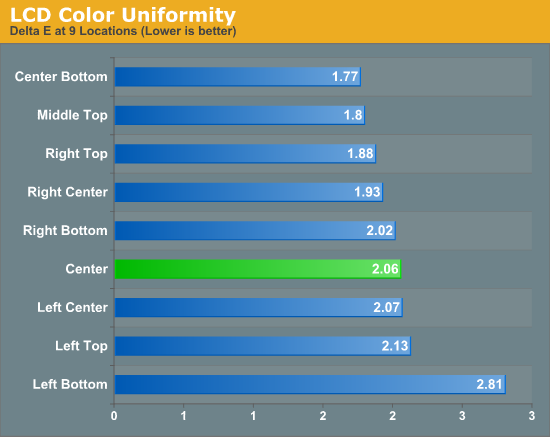


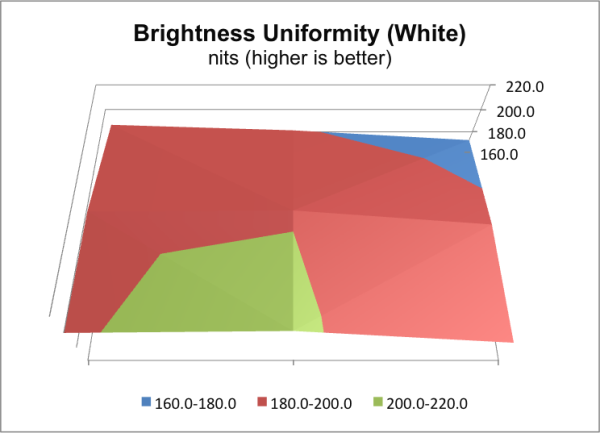
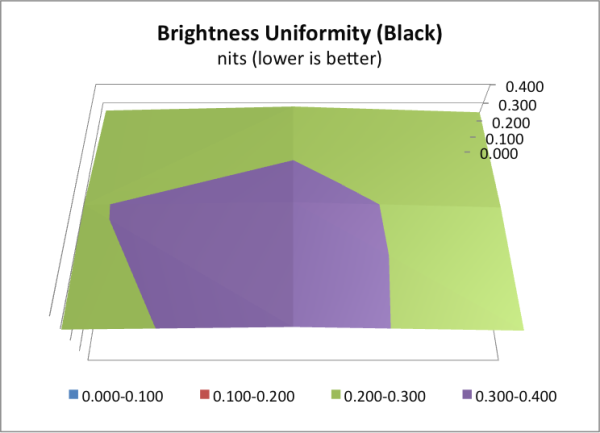
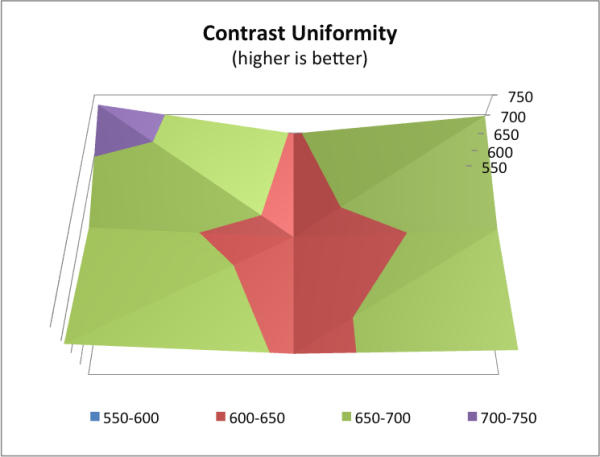
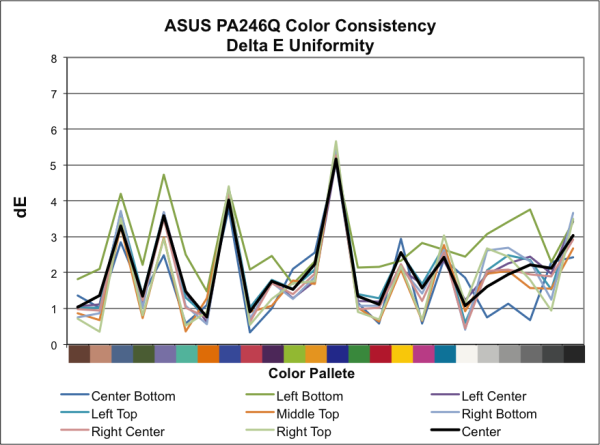
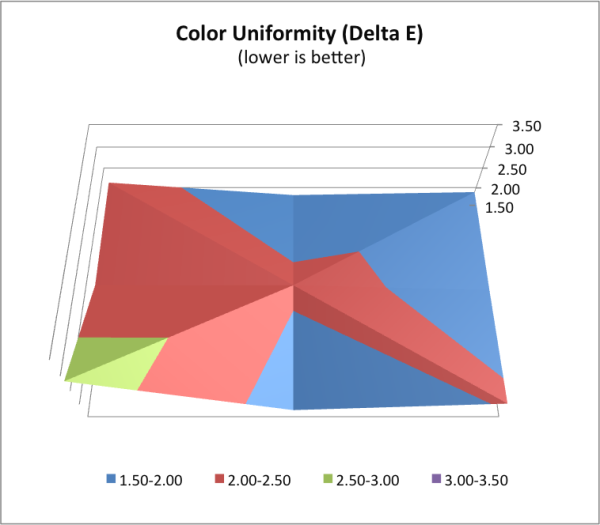








52 Comments
View All Comments
cheinonen - Monday, July 2, 2012 - link
The PA246Q had already been requested, and arrived, when the PA248Q was announced. It also an sRGB monitor as opposed to AdobeRGB, so a better comparison for it might be the Dell U2412M, whereas the PQ246Q competes with the Dell U2410. Using such a similar model number is annoying, but really they're complementary products and not competitive ones.Leyawiin - Monday, July 2, 2012 - link
Yep - its coming to market late this month (and I think I'm going to pop for one at that price).Spoogie - Monday, July 2, 2012 - link
There are serious quality control issues with this model. On my second one in six weeks. 1) humming noise, 2) flickering, and 3) goes blank randomly for 1-3 seconds. The first one did both one and two, the second one has all three problems.I'd return it if I wasn't past the 30-day return window.
aranyagag - Tuesday, December 11, 2012 - link
mine was perfectDevo2007 - Monday, July 2, 2012 - link
It appears you are missing the results for this monitor in the "Calibrated for Print Average Delta E" graph..cheinonen - Monday, July 2, 2012 - link
Sorry about that, fixed it now, not sure how it got left out.funkforce - Monday, July 2, 2012 - link
Fantastic review! Even better than many on sites dedicated to TFT-reviews only.I hope there are a lot more of these to come and I would really like to see more on:
What progress has been made in the last years and what are the top monitors in each field/technology today for non-pro users?
(PVA/MVA/AMVA vs. IPS/eIPS vs. TN technology/best in class.)
What would be the best non-TN panel for gaming today?
Does performance differ a lot on the HDMI and DVI-output on the same panel? (In cases where both exists)
Would it possible to manufacture a LED, 120hz, IPS/VA, 2560x1440, with minimum input lag, near accurate colors and good blacks in the near future?
Will OLED make this a reality?
On most comparison sites for shoppers there are a lot of customer reviews that are mentioning problem with backlight bleeding on most IPS panels.
It would be awesome if you could get an extra retail sample of every monitor you review to see if there's a big difference between to identically named panels.
(I know a guy that bought two would be identical LG screens from the same store where one was manufactured in China and the other in Poland and they differed a lot).
Although I understand if it would be an unreasonable wish.
I just bought a LG IPS236V and it has some backlight bleeding in both the lower left and right corner. It has a gamma setting that goes from 1.8-2.6 where the default 2.2 and above unfortunately only emphasizes the problem. Only the very bright setting of 1.8-2.0 (lower is brighter) result in very little bleeding but blacks are not so dark as one would wish.
It has several options greyed out, like black level and white balance no matter if you use an HDMI or DVI Cable. Is this normal and do you see it on lot of screens during your reiviews?
Many thanks in advance!
funkforce - Monday, July 2, 2012 - link
You can disregard my last question about the white balance and black level. Totally missed that page in the manual about it only being available on DSUB and HDMI.rickon66 - Monday, July 2, 2012 - link
I applaud them for building a computer monitor 16:10 and not a TV set 16:9. Thank You ASUS!Any monitor larger than 23" @1080p = FAIL!
Olaf van der Spek - Monday, July 2, 2012 - link
Right. 4:3 @ 1920 x 1440 or 2048 x 1536 would be even better. :p